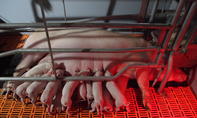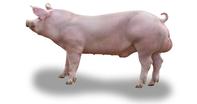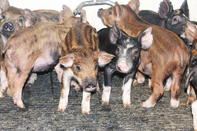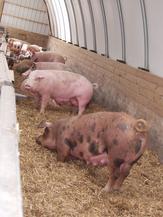
Health
Breeding animals should be healthy. So look for signs of distress, illness and parasite infestations before buying or taking new animals in your herd. A healthy pig, according to the South African Pork Producers Organisation’s Pigs for profit manual, should be breathing normally and not be coughing, sneezing, wheezing, dribbling or frothing saliva.
They should have shiny coats, not be scratching too much or have any wounds, scabs, discoloured patches, thickenings or growths. It is best to buy stock from reputable breeders, but if you are going to buy at an auction ensure you know the origin of the pig and request a veterinary health certificate.
Boars that are shared between different farmers carry a high risk of contracting sexually transmitted and other diseases, so make double sure these boars are healthy before using them in your own herds. Newly acquired boars or sows should be kept separate from the rest of the herd for at least four weeks.
During this time the animals should be evaluated for diseases, treated for parasites to prevent new parasites from being introduced in your own herd and be vaccinated if necessary.
Body Conformation

The pigs should not have any defects or physical abnormalities. According to Pigs for Profit, sows and boars selected for breeding should have a strong straight back and strong straight legs and feet. If they have trouble moving, they are not suited for reproduction.
The boars should have two well developed testicles and should become excited in the presence of a female in heat. An unimproved sow should have at least ten prominent evenly spaced teats, whereas an improved sow should have at least 14. The sows should have a deep body with room for a big litter.
Inbreeding

Inbreeding is caused when closely related animals, such as siblings or parents and offspring, are mated with one another. It not only increases the risk of genetic abnormalities being carried over to their offspring, but also has a negative impact on reproduction.
The Food and Agriculture Organisation of the United Nations (FAO) recommends that purebred boars and females used for mating, should not have a common ancestor for at least four generations back in the pedigree.
Producers should, therefore, keep record of family lines on their own farms and take care to only buy in or use boars that are unrelated to the lines on their farm.
Body Condition

 When starting a pig farm, you need to choose a breed that would suit your level of skill and management. According to Pigs for Profit by Drs...
When starting a pig farm, you need to choose a breed that would suit your level of skill and management. According to Pigs for Profit by Drs... Since no breed is perfect and each breed has its own unique strengths and weaknesses, the selection of a breed is entirely a matter of perso...
Since no breed is perfect and each breed has its own unique strengths and weaknesses, the selection of a breed is entirely a matter of perso... The Kolbroek is an indigenous South African breed. The first Pietrains were imported into South Africa in 1997. The Hampshire derived from t...
The Kolbroek is an indigenous South African breed. The first Pietrains were imported into South Africa in 1997. The Hampshire derived from t...